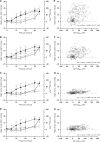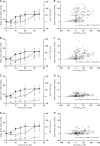Quantitative lung ultrasound detects dynamic changes in lung recruitment in the preterm lamb
- PMID: 36167816
- PMCID: PMC10172106
- DOI: 10.1038/s41390-022-02316-0
Quantitative lung ultrasound detects dynamic changes in lung recruitment in the preterm lamb
Abstract
Background: Lung ultrasound (LUS) may not detect small, dynamic changes in lung volume. Mean greyscale measurement using computer-assisted image analysis (Q-LUSMGV) may improve the precision of these measurements.
Methods: Preterm lambs (n = 40) underwent LUS of the dependent or non-dependent lung during static pressure-volume curve mapping. Total and regional lung volumes were determined using the super-syringe technique and electrical impedance tomography. Q-LUSMGV and gold standard measurements of lung volume were compared in 520 images.
Results: Dependent Q-LUSMGV moderately correlated with total lung volume (rho = 0.60, 95% CI 0.51-0.67) and fairly with right whole (rho = 0.39, 0.27-0.49), central (rho = 0.38, 0.27-0.48), ventral (rho = 0.41, 0.31-0.51) and dorsal regional lung volumes (rho = 0.32, 0.21-0.43). Non-dependent Q-LUSMGV moderately correlated with total lung volume (rho = 0.57, 0.48-0.65) and fairly with right whole (rho = 0.43, 0.32-0.52), central (rho = 0.46, 0.35-0.55), ventral (rho = 0.36, 0.25-0.47) and dorsal lung volumes (rho = 0.36, 0.25-0.47). All correlation coefficients were statistically significant. Distinct inflation and deflation limbs, and sonographic pulmonary hysteresis occurred in 95% of lambs. The greatest changes in Q-LUSMGV occurred at the opening and closing pressures.
Conclusion: Q-LUSMGV detected changes in total and regional lung volume and offers objective quantification of LUS images, and may improve bedside discrimination of real-time changes in lung volume.
Impact: Lung ultrasound (LUS) offers continuous, radiation-free imaging that may play a role in assessing lung recruitment but may not detect small changes in lung volume. Mean greyscale image analysis using computer-assisted quantitative LUS (Q-LUSMGV) moderately correlated with changes in total and regional lung volume. Q-LUSMGV identified opening and closing pressure and pulmonary hysteresis in 95% of lambs. Computer-assisted image analysis may enhance LUS estimation of lung recruitment at the bedside. Future research should focus on improving precision prior to clinical translation.
© 2022. Crown.
Conflict of interest statement
The authors declare no competing interests.
Figures





References
-
- De Luca, D. et al. Personalized medicine for the management of RDS in preterm neonates. Neonatology118, 127–138 (2021). - PubMed

